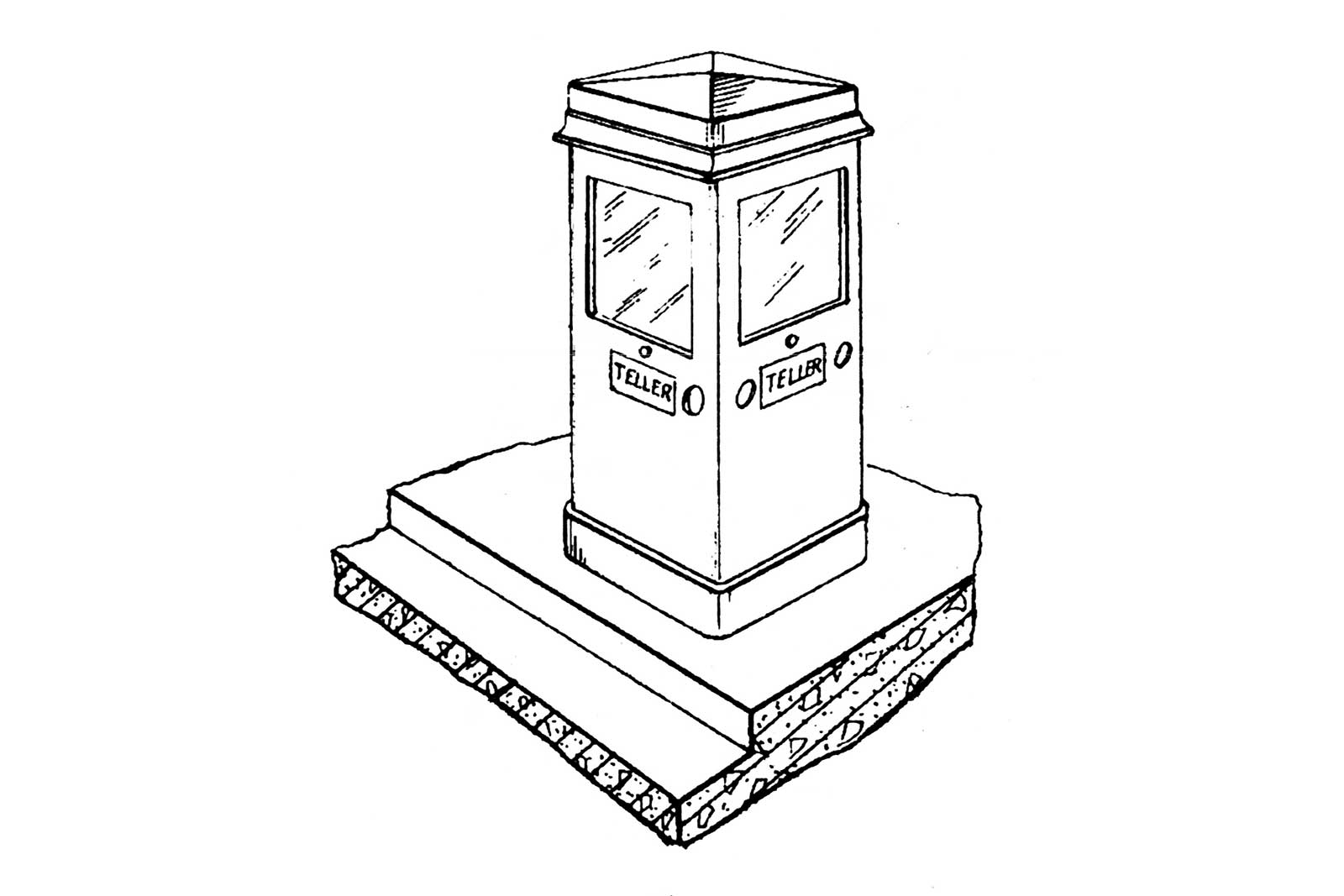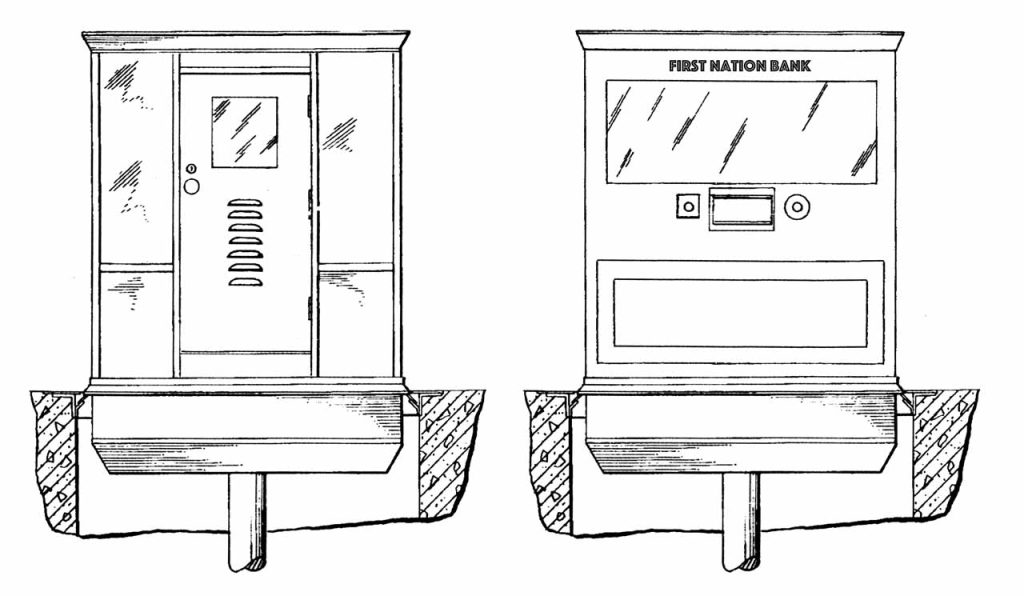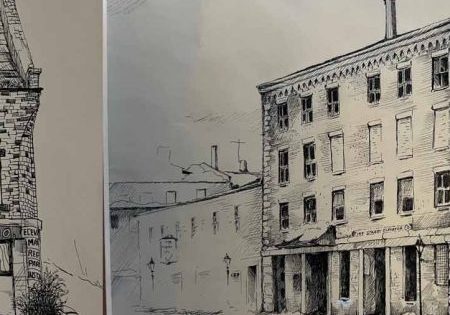Elevated Banking in the 1950s
May 1, 2025

Retractable sidewalk teller systems
The 1950s witnessed the development of numerous technological innovations that changed how people interacted with their physical environment. Many of these innovations, such as the operator-less elevator, were predicated on the “modern” concepts of speed, efficiency and convenience. These attributes were also embraced by the banking industry, most noticeably in the development of drive-up banking, which allowed customers to conduct business from their cars. The vertical-transportation (VT) industry played a brief role in the development of these systems with the short-lived utilization of retractable sidewalk teller systems — which were also known as jack-in-the-box teller cages.
The October 15, 1950, edition of Texas’ Lubbock Avalanche-Journal included an article that announced:
“Depositors at the Lubbock First National bank will soon be able to drive by, hand their deposit to a sidewalk teller and drive on without getting out of their car. Construction of three new teller’s cages which will rise out of the sidewalk on the north side of the bank building at Texas Avenue and Main Street, is scheduled to begin immediately. When not in use, the cage will drop into a basement and out of sight. Completion is expected within the next 60 days, possibly sooner, in time for the Christmas rush … Cost of the cages and the basement which will house them is estimated at about US$18,000, with the Gilstrap Construction Company as contractor. The basement will run the entire length of the bank building and will be 99 x 15 ft in size.”[1]
The newspaper published an update on the project in mid-November:
“A first in the U.S. is the sidewalk teller-cages project of the First National bank at Main and Texas. The excavation underway here is for a basement and the installation of three teller-cages. These cages will be on hydraulic lifts and raised to the curbs. … The cages will be the size of theater ticket booths. Superintendent of the Gilstrap Construction Co. project is Bob Burgoon. Company spokesman said that while Amarillo and some other cities have outside teller cages, the Lubbock cages will be the first that can disappear from the curbs.”[2]
The project, perhaps not surprisingly, took longer to complete than was first imagined, and the sidewalk teller cages did not begin operation until June 1951:
“Tellers of the First National Bank at Lubbock, Texas, have had their ups and downs since June 11. On that day, three curb teller cages operating on an elevator basis, believed to be the first in the nation, went into operation. The units operate somewhat like a sidewalk freight elevator, being placed in position on the sidewalk during banking hours and lowered into the basement at closing time by a system operated by the teller. The bank has a rental arrangement for use of the sidewalk with the City of Lubbock. Each cage is equipped with bullet proof glass, inter-communication system, telephone, venetian blinds and heating and air conditioning from the bank’s main unit. … The Mosler Safe Co. constructed the cages and Hunter-Hayes Elevator Co. installed the elevators.”[3]
The March 1953 issue of ELEVATOR WORLD also featured an account of this installation which noted that:
“With the exception of the cage, the equipment for these installations is designed and manufactured by the Rotary Lift Co. in their Memphis plant. They have engineered for this application a pump and piston combination with a specially stabilized platform and car sling. The door of the cage is inter-locked so that the car cannot be lowered until this door is closed. A collapsible gate protects the lower landing and is also interlocked so that it cannot be opened when the cage is away from the basement level. The only control is from within the cab, by an ‘Up-Down’ push button station adjacent to the teller’s window.”[4]
These articles provide a relatively comprehensive account of this innovative elevator system. The only missing piece of information is the name of the inventor of the retractable sidewalk teller cage.
The Burroughs Clearing House (a financial journal) reported, “The original idea for the sidewalk cages was worked out by the officers and directors of the bank: construction was handled by the Mosler Safe Co., Hamilton, Ohio, working from the bank’s plans.”[5] EW provided even greater specificity, reporting that the idea “was the brainchild” of bank Vice President Roy Riddel and bank Director Alex McDonald. However, while Riddel and McDonald may have come up with the idea, there remains another important question: Who made their idea a reality? The answer is Clarence D. Ellithorpe (1898-1964).
A human-interest story, published in the New York Daily News in 1964, described Ellithorpe as:
“round, agile, expressive (and) responsible for 16 patents on anti-bandit and sidewalk banking devices. He is considered one of the country’s leading authorities on such things. … He comes from Gloversville, NY. At 14, he was a bellhop at the old Waldorf-Astoria, attending Cooper Union at night. At 22, he was running the factory for the Duplex Electric Co.”[6]
While the article’s author was, perhaps, slightly less accurate than they could have been (for example Ellithorpe earned only 10 patents), they did capture his inventive spirit:
“For city banks he developed a sidewalk banker with a snorkel that led down to a teller in the basement … equipping them with intercoms and mirrors so tellers and customers could see and talk to each other. ‘Then I got to thinking,’ he says. ‘Why not remote banking, with a TV camera for customers 2,000 ft away or more?’ He called it the TV autobanker. The deposit is carried underground to the teller by pneumatic tube. Teller and customer communicate with each other over closed-circuit TV. He installed the first one in a Bridgeport, Conn., bank in 1956. Diebold Safe and other companies are now making them. Each cost about US$100,000. There are over 100 in use. And Ellithorpe dreams of putting them in skyscraper offices with the bank at street level, so everybody in the building can bank without leaving the office. ‘And they’re completely burglar-proof,’ he says. ‘No bandit can stickup a TV picture.’”[6]
The “snorkel” teller station was originally designed as a freestanding kiosk that could be placed on a sidewalk such that bank customers in cars or on foot could make deposits (Figure 1). Interestingly, the article’s author did not reference the fact that Ellithorpe had also designed a snorkel teller system mounted on a hydraulic piston, which allowed the kiosk to “disappear” when the bank closed (Figure 2):
“In prior devices, the sidewalk teller stand has been mounted permanently in a position projecting upwardly from the sidewalk. … Because of the permanent mounting of the previous stands, they may obstruct pedestrian traffic and may be subject to night vandalism.”[7]



The author also failed to mention that Ellithorpe held the patent for the retractable sidewalk teller cage.
The application for Ellithorpe’s 1953 patent, Retractable Sidewalk Teller System, was filed on November 21, 1951, four months after the three Lubbock sidewalk tellers began operation. Given that their construction was announced in October 1950, it may be reasonable to assume that work on their design began several months prior to that date. The seven-month construction period may have also included time spent by Ellithorpe perfecting the cage design and working with Rotary and Hunter-Hayes on installation details. Thus, the patent drawings may illustrate the actual Lubbock system (Figures 3 and 4). The patent text supports this assumption in that the details of the cage construction and elevator operation match those found in the published accounts. In Ellithorpe, Riddel and McDonald found an ideal partner to bring their idea to life, particularly given that, as was disclosed in the Daily News interview, he excelled at the exploration of Rube Goldberg type designs.[6]
Tragically, Ellithorpe was killed in a car accident three months after the Daily News interview.[8] He did, however, have the opportunity to see his elevator teller cage system employed across the U.S.. Inspired by the Lubbock example, the National Bank of Commerce in Pine Bluff, Arkansas, installed an elevator teller cage in early 1953.[9] The installation was completed by the Southern Co. of Memphis.[4] In January 1954, work began on the installation of an elevator teller cage for the Citizens National Bank in Decatur, Illinois.[10] This was followed by an elevator teller cage for the Barnett National Bank in Jacksonville, Florida, (completed in May 1955) and the installation of three elevator tellers for the First National Bank of Chickasha, Oklahoma (completed in November 1955).[11,12] The latter installation closed following the example set by the Lubbock bank:
“The First National Bank of Lubbock, Texas, introduced curb tellers to the nation and received wholesale publicity in dozens of national banking magazines. The local curb teller cages are identical to those installed by the Texas bank. They were installed at a cost of US$20,000. … The cages, completely bullet-proof with large panels of glass on three sides, contain a two-way speaker system and telephone, and will be completely air conditioned. They go up and down on hydraulic lifts, descending to the bank basement where the tops fit flush with the sidewalk.”[12]
One of the last installations that employed Ellithorpe’s design was built for the Community National Bank in Pontiac, Michigan, which completed a “disappearing” sidewalk teller cage in February 1957.[13] Ironically, this installation, quite possibly the last, received the most publicity with illustrated articles appearing in more than 30 newspapers in Canada and the U.S.
Ellithorpe’s design did inspire one “copy-cat” installation. In March 1955, the South Side Bank & Trust Co. of Chicago completed the installation of an elevator teller cage located in a parking lot adjacent to the bank building:
“A bank teller’s cage that rises in the middle of a parking lot during business hours and descends into a basement when not in use was placed in operation recently by South Side Bank and Trust Co. … The facility, believed to be the first of its kind, was designed when the bank saw the need to expand its drive-in banking department and, because of space limitations, could not install a second drive-in window in the bank building … The 6 by 71/2 ft structure has heavily insulated sides of armored plate steel and is covered with decorative aluminum siding. The windows are bullet proof glass, and the roof is a flat steel plate. A retractable canopy with floodlights extends above the teller’s window. Inside there is a telephone and a two-way communications system with other departments. The cage is both heated and air conditioned. A hydraulic lift raises and lowers the structure, and no one can enter or leave it when it is above ground. Money received during the day is taken by hydraulic lift out of the lowered cage and delivered directly to the bank vaults.”[14]
A.A. Henkel & Associates, bank designers and engineers located in Chicago, were credited as the designers of this “first of its kind” system.
Given that Henkel regularly advertised in banking magazines, many of which carried numerous articles on elevator teller cage systems, it is hard to imagine that Henkel was unaware of these machines. With the exception of Henkel’s machine, all of the other installations involved the Mosler Safe Co. — Ellithorpe worked for the Duplex Electric Co., a wholly-owned subsidiary of Mosler — and thus these installations embodied his design and they were identical in appearance. While the Chicago installation did not resemble the Ellithorpe/Mosler machines and thus was “unique” in its appearance, and its location in a parking lot (as opposed to a sidewalk) was also “unique,” it was, perhaps, stretching the truth to claim that it was “the first of its kind.”
A final missing piece of this story concerns how long bank users had the pleasure of seeing their teller gracefully rise up from and descend beneath their city’s sidewalks. The First National Bank in Lubbock decommissioned their three elevator teller cages in early 1955 when the bank moved from its uptown location. The fate of the other systems is unknown at this time. However, at least for a while, the humble sidewalk elevator had been transformed by the imagination of two bank officers and the inventive skills of Clarence Ellithorpe into a dynamic example of 1950s modernity.
References
[1] “New Sidewalk Teller Cages Planned Here,” Lubbock Avalanche-Journal (October 15, 1950)
[2] “Downtown Lubbock Buildings Getting Million-Dollar Face-Lifting,” Lubbock Avalanche-Journal (November 19, 1950).
[3] “Elevator Curb Teller Cages Installed by First National at Lubbock,” Mid-Continent Banker (August 1951).
[4] “Oildraulic Bank Teller Cage Elevators, ELEVATOR WORLD (March 1953).
[5] “Tellers’ Ups and Downs,” Burroughs Clearing House (August 1951).
[6] Sidney Fields, “Only Human: Puts Stickupmen on Camera,” New York Daily News (May 13, 1964).
[7] Clarence D. Ellithorpe, assignor to Duplex Electric Co., Inc., Retractable Sidewalk Teller System, U.S. Patent No. 2,656,013 (October 20, 1953).
[8] “Clarence Ellithorpe is Killed in Crash,” The Bridgeport Post (August 31, 1964).
[9] “National Bank of Commerce of Pine Bluff Has Curb Teller,” Mid-Continent Banker (May 1953).
[10] “Snorkel Here: Start Installing Curbside Teller’s Cage Monday,” Decatur Daily Review (January 9, 1954).
[11] David J. Ginzi, Barnett Bank, Arcadia Publishing, Charleston, SC (2000).
[12] “Curb Tellers Bring ‘Sidewalk Banking,’” Chickasha Daily Express (November 25, 1955).
[13] “Offer New Type of Curbside Bank,” The Kalamazoo Gazette (February 12, 1957).
[14] “Bank Teller’s Cage Has Ups and Downs, Too,” Chicago Tribune (March 3, 1955).
Get more of Elevator World. Sign up for our free e-newsletter.









